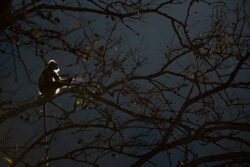It all began when I came across an amateur video on social media, where I saw Malabar Pied Hornbills dust-bathing. The scene and the behaviour were so incredibly dramatic that it goaded me into learning about these birds and setting out to experience the phenomenon myself. I talked to people who had seen and photographed Malabar Pied Hornbills, and all leads led me to Dandeli, a beautiful town in the Western Ghats of Karnataka, in the Uttara Kannada district.
Dandeli’s River Kali is famous for her rapids, and each year, thousands of thrill-seekers flock to Dandeli after the monsoons for white-water rafting and other adventure sports. But the Kali also hides another shy creature on her banks, and that is what I was after.

Birds on the mystical Kali.

The Malabar Pied Hornbill (Anthracoceros coronatus) is a large hornbill endemic to India and Sri Lanka. It has black plumage, a white belly and a large yellow bill with a black casque. These birds grow up to 65 cms in length and weigh about a kilogram. The males of the species have distinctly red eyes as seen in this image, while females (seen in the next image) are identified by their white orbital skin.

Hornbills set off every morning and feed throughout the day (here, a female hornbill is seen in flight). Malabar Pied Hornbills are omnivorous, and although their diet is primarily figs, they consume other small birds, insects, etc. They visit a wide variety of fruiting trees and disperse their seeds far and wide. It is for this reason that they are called ‘farmers of the forest’.

Strychnos nux-vomica, also known as the poison nut tree (Kasarka Mara in Kannada), produces one of their favourite figs; hornbills flock to these trees when they fruit. The seeds of this fig contain a chemical compound called strychnine, which is a neurotoxin. Most other vertebrates do not touch this fruit, but hornbills digest the fruits and excrete the poisonous seeds.

The poisonous seeds of Nux-Vomica, excreted by hornbills. The excreted seeds shine like gold under sunlight.

Malabar Pied Hornbills are one of the few birds that mate for life and are always seen in pairs. During the nesting season, the female shuts herself into a hollow in a tree, and seals the entrance with saliva, mud and excreta. She leaves a small hole that is just big enough for the male to deliver food to her. During this time, the male hornbill shoulders the responsibility of feeding her. She spends the next few months in the sealed nest until the eggs hatch. She will then peck her way out and join her partner in bringing back food for their fledgelings.
In order to digest the fruits they eat, hornbills have to consume mud regularly. In some courtship rituals, the male brings small gifts—mud balls—for the female. This gifting behaviour is a treat to watch, and I shot this video where the male repeatedly brought her mud balls in different shapes and sizes, but for some reason, she rejected them all.

Finally, she accepted his gift and it was a happy ending.
Like a grand finale to the day, every evening, before they get back to their roost, hornbills bathe in fine dust in open agricultural fields.

They have to do this to reduce the oil content in their feathers and to rid them of ticks.

The male and the female take turns to wriggle in the dust, and create a scene that is no less than a spectacle.

If photographed under flat light, the dust does not stand out. I photographed the birds against the light to capture the dust glowing in the evening sun.

A hornbill pair observes human activity from a coconut grove. These birds are extremely sensitive to changes in their environment and spook at the slightest disturbance, so photographing them was a long waiting game. The birds would first land on the coconut trees and watch the area for about half an hour. Only once confident that it was safe would they come down for the dust bath.

As these birds are extremely sensitive to their surroundings, it is best that we exercise the utmost caution while documenting them. If using a hide, ensure that it is covered with as much natural material as you can find, and leave the hide in the open for a couple of days so that the birds are comfortable with it.
Malabar Pied Hornbills are a ‘Near Threatened’ species according to the IUCN. Like with most Western Ghats endemics, habitat loss is one of the biggest threats to these birds, as man encroaches more and more into wilderness. Also, nesting is a very intense, private affair for these birds and it is imperative that they be left alone during that time. In wildlife photography, wildlife must always come first.





Instagram
junglelodgesjlr